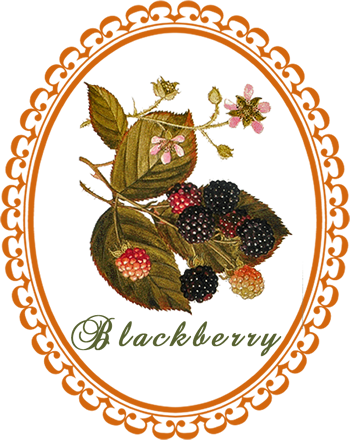
Blackberry: is an astringent, especially for the gastrointestinal tract. It allays excessive fluid loss from diarrhea, and when medical intervention is not available may save lives ...
Common Names: Bramble, cloudberry, dewberry, goutberry, thimbleberry
Botanical Name: Rubus villosus
Family: Rosaceae
Plant Type: Perennial
Parts Used: Root, rhizomes, leaves, fruit
Flowering: June to September
Description: Blackberry is a trailing perennial plant that grows in dry or sandy soil in the northeastern and middle states of the U.S. and is cultivated elsewhere. The slender branches feature sharp, recurved prickles. The leaves are finely hairy with 3 to 5 leaflets. The leaflets are ovate and doubly serrate. The white, five-petaled flowers appear from June to September. The berries turn red as they ripen and become a juicy, purplish blue black by midsummer. The canes are covered in spiny thorns, so one must take care when working with this plant.
Cultivation: Blackberries will produce their absolute best on a medium, well-drained soil which contains plenty of organic matter. They like the soil to hold a good supply of water, especially when the fruits are developing in summer. The best berries will be produced when they are in full sun. However, a blackberry cane will produce good crops even when grown in deep shade.
Harvesting: The leaves should be harvested either before or during flowering. The root should be dug up in summer and dried.
Culinary Uses: The berries that are produced are black in color when ripe and are eaten fresh, baked in pies, preserved in jellies and are eaten in all sorts of other recipes. Berries are eaten right off the vine or used in desserts, salads and jams. Black berries can be made into wine, brandy or used to flavor liqueurs. Some people even use the tender young shoots as vegetables after peeling. The blackberry is related to roses and other berries like the raspberry.
Blackberry Magick
Healing. Money. Protection
Gender: Feminine
Planet: Venus
Element: Water
Diety: Brigit
Burn the dried leaves as incense to attract good luck.
Plant blackberry canes in your garden to attract the fairies.
Sprinkle blackberry leaves outside your home for protection.
Decorate your altar with the canes to invite abundance into your life.
Bake a blackberry pie on Lughnasadh (August 1) to commemorate the harvest.
Meditate under a blackberry plant to talk to the spirits of those who have crossed over.
Healing with Blackberry
Key Medicinal Uses: Diarrhea. Mouth Sores. Sore Throat. Hemorrhoids.
Blackberry is exceedingly valuable in the treatment of chronic diarrhea, dysentery, cholera, and other problems with ‘loose bowels’, even among infants and children. Blackberry is an excellent, safe and gentle astringent remedy that can be used in all situations that call for this action. It can be taken to help lessen a woman’s heavy menstrual cycle without suddenly ending it entirely. A decoction of the root or leaves or both may be taken four to five times a day. The tea made from blackberry leaves is good for appendicitis, upset stomach, leucorrhea and enteritis. Blackberry vinegar has been used for colds with fever.
Blackberry leaves can be chewed to relieve bleeding gums. For a sore mouth and inflamed throat, gargle a tea made from the roots and leaves as often as necessary. An infusion can be applied to the skin for scaly conditions or to help psoriasis. A poultice made from slightly boiled fresh leaves can be applied for skin conditions and burns. Blackberry leaves, bruised and applied outwardly, will act as an astringent to hemorrhoids.
Herbs to Combine/Supplement: Blackberry leaves are often combined with other herbs like rosehips in herbal teas.
Dosage:
Decoction: Use 1 tsp. root or leaves to 1 cup water. Take 1 to 2 cups a day, cold.
Tincture (of root): Take 15 to 40 drops in water, as needed.
Contraindications:
- If you are suffering from chronic gastrointestinal conditions such as colitis, do not use blackberry roots. Blackberry root bark contains the most tannin followed by the leaves and finally the fruit.
- Use blackberry in medicinal amounts and under the supervision of a qualified professional. If you experience nausea or vomiting, stop using it immediately and contact your doctor.
If you appreciate the information provided,
please help keep this website running. Blessings!
© 2008-2025 aromaworx.ca. All rights reserved.

